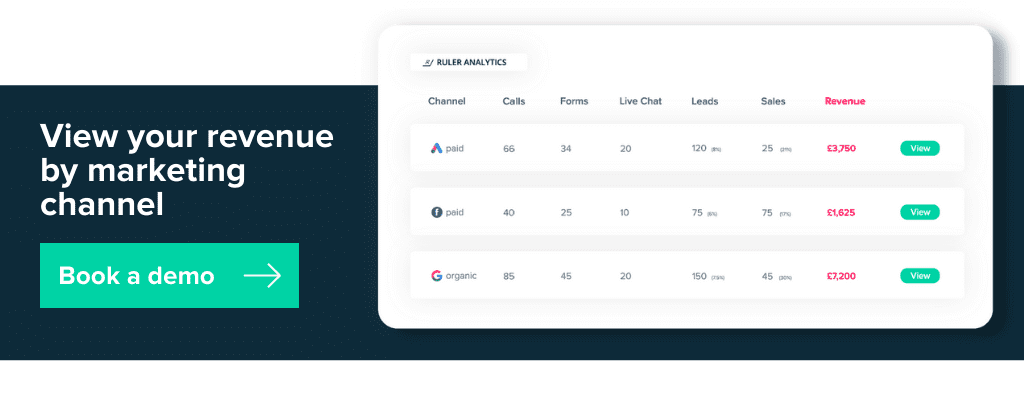By tracking the right B2B metrics, you can make informed data-driven decisions to boost the performance of your marketing strategies.
Data analytics has become an integral part of the B2B marketing landscape.
With the technology available, B2B marketers have an abundance of data and metrics right at their fingertips.
Talk about a double-edged sword, though.
Having access to all this information can also pose one of the biggest challenges that B2B marketers face.
Why? Because it’s easy to get lost in the sea of analytics.
Especially when it comes to choosing the right metrics to prove your worth to your clients and executives.
To differentiate important metrics from not-so-important metrics, you need to understand how other marketers measure B2B marketing.
And that’s what we’re going to discuss in this article.
What you’ll learn:
Pro Tip
Ruler Analytics can help make your marketing reporting easier. We provide marketers with the data they need to connect their marketing activities to closed revenue and help them track important metrics like ROI, ROAS and CPA.
Learn more on how to measure your marketing with Ruler
Metrics are a must-have in B2B marketing.
B2B metrics are quantifiable measurements used to evaluate your marketing performance. They are the foundation of any successful campaign.
Related: How to measure your marketing performance
By regularly tracking and assessing your marketing through metrics, you can determine if your efforts are moving you towards success or failure.
The answer is simple.
Without B2B metrics, marketing teams wouldn’t have a clear picture of whether or not their marketing strategies are a success. But that’s not the only reason why you should track metrics.
Measuring B2B metrics can also:
1. Support data-driven decision-making and marketing planning: To make effective decisions in marketing, you need to rely on metrics. Once you’ve identified your most valuable metrics, you can gain the information you need to back up your instincts and facilitate better decision-making.
2. Assist in budget allocation between different campaigns: Without B2B metrics, how do you know where to allocate your budget? You don’t. With the right B2B metrics, you can identify your best-performing marketing campaigns and reinvest your budget into those areas to scale your efforts.
3. Help prove the ROI of your marketing efforts: Without the marketing team, there are no leads. And yet the marketing team is often last to receive any praise for their role in driving business growth. By using B2B metrics like ROI and ROAS, you can show your impact on revenue and get the credit you deserve.
There are tons of B2B metrics to choose from, and all have their strengths and weaknesses. However, there are a few metrics that every B2B marketer should be tracking with care.
Here’s a rundown of what they are:
Categorised as warm leads, MQLs are leads that have indicated enough interest to be considered qualified. But not hot enough to be considered as sales qualified leads (SQLs).
Usually, an MQL is a lead that has engaged with your brand through actions like repeat visits to your website, clicking on an ad to find your site, filling out an opt-in form or subscribing to a newsletter.
Or better still, signed up for a product demo.
These are leads that are curious and open to the idea of buying. They’ve taken the initial step in engaging with your brand but need a little more persuading to convert.
Related: What is lead tracking? (+ 11 tips on how to get started)
It’s important to note that not all MQLs are equal, all act differently and some will never go any further.
So how do B2B marketers identify “quality” marketing qualified leads?
By defining criteria based on your other leads buying habits.
This can be done by analysing historical buyer behaviour.
B2B marketers can use existing data from previous campaigns to track the path an MQL took to become an SQL.
It’s even possible to find out what successful leads have in common by examining trends such as what ads convert the highest MQLs or what landing pages yielded the highest sign-ups.
Pro Tip
Are you struggling to identify where your leads are coming from? Ruler can help. It tracks data on a visitor level, allowing you to successfully attribute CRM leads and revenue back to your campaigns, ads, keywords, landing pages and more.
How to track where your leads come from with Ruler
SQLs are much hotter leads that indicate a much stronger intention to buy.
An SQL is a potential lead that has been researched and vetted by the B2B marketing team and pushed through a funnel to the sales team.
Related: How to build a lead generation funnel
During this process, leads are put through a lead scoring system to determine their worthiness as leads or potential customers.
Values are attached based on their behaviour relating to their interest in products or services.
For this methodology to work, B2B marketing teams and B2B sales teams need to agree on the criteria and definition of a qualified lead, for the values to mean anything.
Related: Lead value: What is it and how to track it
Having these values in place allows the marketers to target serious buyers and save the sales team time in following up on the lead.
The faster the follow-up with an SQL, the higher the close rate.
The following is an example by LeadFuze, of how an MQL is moved through a sales cycle from the marketing team and depending on the criteria and actions taken by the lead, converted to an SQL by the sales team.
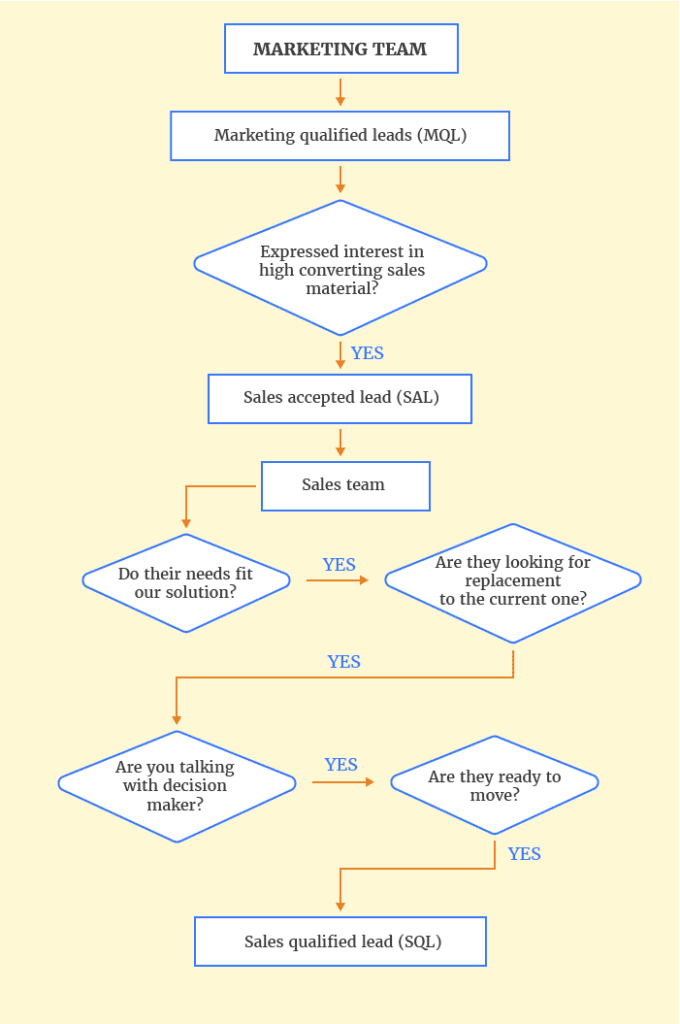
Now, an SQL is ready for the next stage of the sales process.
They’ve gone past the engagement stage and they’re ready to be converted into a customer. The collaboration of B2B marketers and B2B sales personnel is vital to the process.
Related: Sales and marketing alignment: a complete guide
If you’re an advertiser worth their salt, you’ll know how cost per lead (CPL) works.
Cost per lead is the amount of money it takes to generate a new prospective customer via your ad or marketing campaign.
Related: Cost per lead: Is your marketing effective?
To calculate your cost per lead, take your marketing spend for a given period and divide that by your total number of leads, and you’re good to go.
While CPL can be a useful budgeting metric for marketing, it does have one major flaw.
Cost per lead doesn’t consider the quality of your prospective customers.
There’s a common misconception that the lower the cost per lead, the greater the return. But this couldn’t be any further away from the truth.
Not all leads are worth the same value, nor are they all sales-ready.
Just because you’re generating a boat load of leads for little to no cost doesn’t mean it’s impacting your bottom line.
To really understand the value of your B2B marketing, you need to look beyond leads and focus on revenue metrics (we’ll get to these in a sec).
The B2B metric cost per acquisition (CPA) is the total cost of acquiring a new customer via a specific marketing channel or campaign.
To calculate cost per acquisition, you divide the total costs of all acquisitions by the number of new customers in a certain timeframe.
Cost per acquisition is similar to cost per lead (CPL), but this metric is used to measure the revenue impact of your marketing efforts.
Take the table below, for example.
| Campaign name | Leads | Cost | Cost per lead |
| Campaign 1 | 25 | £500 | £20.00 |
| Campaign 2 | 5 | £500 | £100.00 |
| Campaign 3 | 20 | £500 | £41.66 |
Considering only lead quantity and cost per lead, ad campaign 1 is the top performer. For the same cost as campaigns 2 and 3, it has delivered more leads for a lower cost.
Any marketer with a desire to grow revenue would allocate all their resources into it to campaign 1, right?
Let’s not be hasty.
Before we land on any decisions, let’s add customer data to the mix.
| Campaign name | Leads | Cost | Cost per lead | Customers | Cost per acquisition |
| Campaign 1 | 25 | £500 | £20.00 | 7 | £71.42 |
| Campaign 2 | 10 | £500 | £50.00 | 8 | £62.50 |
| Campaign 3 | 20 | £500 | £41.66 | 15 | £33.33 |
Big difference, right? By adding customer data, we can now see that campaign 3 had the best impact on paying customers despite generating a lower volume of leads.
Getting caught up in cost per lead is an easy trap. Cost per lead is easy to work out, and it makes your marketing look more successful.
But, what really matters is how your campaigns translate into customers.
As you can see from our example, cost per lead alone isn’t enough to give you that insight.
With cost per acquisition, however, you can find out how much it costs to get an active or paying user.
You can use cost per acquisition to optimise your campaigns based on actual conversions and drive more qualified leads for your sales team.
This metric is another essential indicator in B2B marketing measurement. It allows the B2B marketer to measure how quickly high-quality leads are moved through the sales pipeline.
From beginning to end. Time is taken from first engagement to money spent by the lead.
It also allows B2B marketers to gauge how much revenue is generated from individual pipelines.
This can be filtered by duration down to monthly, weekly or daily revenue made which also enables forecasting.
Pipeline velocity is usually measured by calculating the number of quality leads engaged, lead win rate and money spent.
This is then divided by the amount of time taken to move the lead through the entire sales cycle.
B2B marketers usually rely on their CRM to give them insights into win rates and lead engagement.
There are two ways that B2B marketers can improve their pipeline velocity. By speeding up the deals that are moving through the pipeline and increasing the number of quality leads.
Related: 27 tips to close deals faster
This brings us back to highlight just how important the B2B marketing measurement of MQLs and SQLs are.
Ensuring a B2B company has defined exactly what the criteria of a quality lead looks like eliminates the number of unqualified leads being sent to the sales team.
This, in turn, removes leads with zero buyer intent and time wasted. Thus speeding up the deals in the pipeline and allowing the whole sales cycle to run more efficiently.
Tracking return on investment (ROI) is a crucial B2B metric for any marketer.
It’s the most effective way to prove which marketing investments work for your company.
If you’re not already measuring ROI, it’s time you make it a priority.
Return on investment is the practice of attributing profit and revenue growth to the impact of your marketing efforts.
While ROI is important, it’s not always easy to track.
With consumers using more marketing touchpoints to research and purchase products and services, gaining an accurate view of ROI is an escalating challenge for marketers.
In fact, during our survey, we found that just over half of marketers are confidently tracking marketing ROI.
Luckily, there are tools out there that can help track your ROI. Keep reading, and we’ll take you through our unique process for tracking B2B marketing and ROI.
If you run paid ads, return on ad spend (ROAS) is one metric you should keep an eye on.
To work out your ROAS, simply divide your revenue by the amount of money you spent on ads.
At a glance, ROI and ROAS sound familiar, right?
But they aren’t quite the same.
At the most basic level, ROAS measures the effectiveness of your advertising efforts. ROAS measures the amount of revenue your business earns for each dollar it spends on advertising.
ROI, however, is used to determine the profitability of your overall marketing efforts and can include other expenses such as tools and even staff wages.
Despite their differences, both metrics provide useful insights into the profitability of your campaigns and play a big part in increasing your company’s revenue.
Last but certainly not least, we have lifetime value.
If you have clients on a retainer, lifetime value is an incredibly useful metric to track your marketing effectiveness.
It’s so valuable that 59% of SaaS marketers consider customer lifetime value a primary metric to demonstrate marketing success.
To calculate lifetime value, all you need to do is multiple the value of a customer by their average lifespan.
For example, let’s say you onboard a customer for £1000 per month.
They stay with you for 6 months before ending their relationship with you. In this case, the lifetime value for this customer would be £6,000.
Lifetime value has a lot of importance. It lets you know how effective your retention is and shows how well your marketing is doing to drive loyal and profitable customers.
So far, we’ve highlighted the most important metrics to track and measure your B2B marketing.
We know that the low cost per lead isn’t always dependable and that revenue metrics are essential in demonstrating the health of your campaigns.
For the next part of this guide, we’re going to show you how we measure the value of our B2B marketing.
Like most businesses, we make decisions about our marketing based on its potential to drive more revenue.
The process we use to measure B2B marketing also supports how we accurately calculate our ROI, LTV and ROAS.
Here is a step-by-step of how we would measure the success of our B2B marketing efforts:
First, we ensure that our visitors are captured on an individual level.
By doing this, we can match our closed deals with the marketing source and measure the value of our campaigns, keywords and landing pages further down the line.
More importantly, tracking visitors individually gives us a more accurate look into what pages an anonymous visitor engaged with over multiple sessions before converting into a lead.
To track visitors, we use our product, Ruler Analytics.
Ruler is a marketing attribution tool that uses first-party cookies to identify your website users and tracks their unique journeys over multiple traffic sources, ads, keywords and more.
Take the journey below, for example.
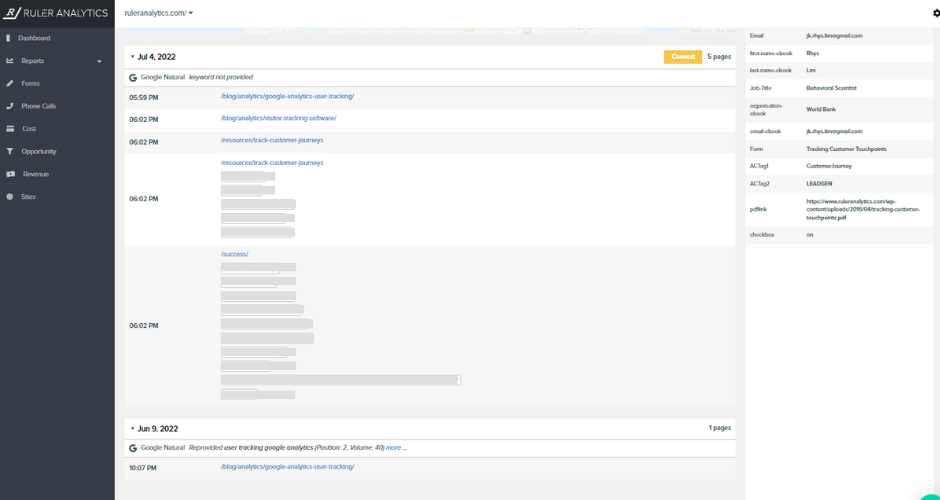
We can see this specific user used the search term “user tracking google analytics” and landed on one of our blogs. Five days later, they returned to the initial blog. However, on this occasion, they viewed another blog on visitor tracking tools and downloaded an eBook on customer journeys.
Without Ruler, we wouldn’t be able to track the unique touchpoints of our anonymous visitors and the process of attributing revenue back to our leads would be near impossible.
Pro Tip
Tracking customer interactions across multiple channels unlocks powerful insights that you can use to improve your customer experience and marketing efforts. See how Ruler can help you follow the complete lifecycle from awareness to loyalty.
How Ruler tracks full customer journeys
When an anonymous visitor converts into a lead, we match the user’s details to their individual marketing touchpoints.
A lead could convert by phone call, form or live chat, but we can easily track these mediums using our marketing attribution and lead capturing software.
Related: Track where your leads come from with Ruler
This marketing data is then sent to our CRM.
At this point, you’re probably wondering why this is even necessary.
After all, most CRMs offer built-in source fields that identify where your leads first originated.
The issue with lead source fields in the CRM is that they often merge all your digital channel activity into one category, such as “Web” or “Online”.
While handy to have, lead source fields don’t tell you much about the effectiveness of your specific marketing efforts.
But by integrating Ruler with our CRM, we can track every interaction a lead has had with our marketing campaigns before the ultimate conversion.
Take the screenshot below, for example.
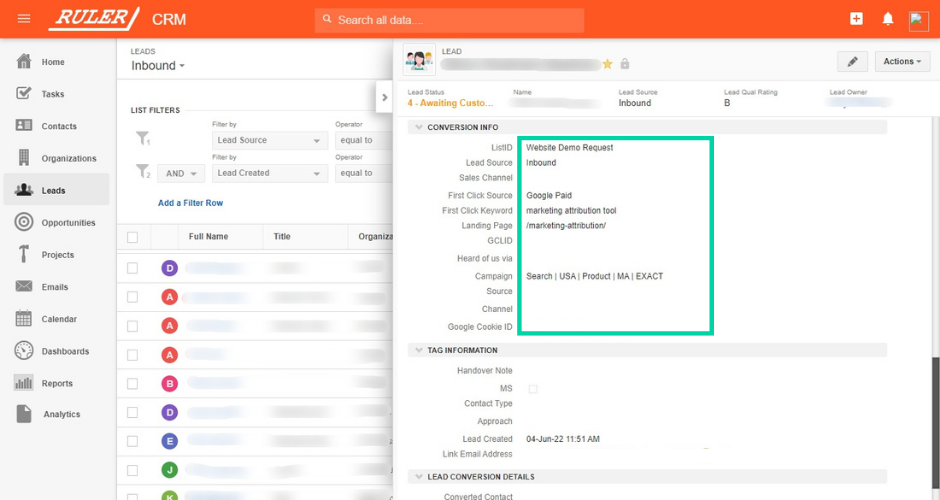
After applying Ruler’s data, we can see that this lead in our CRM searched the keyword “marketing attribution tools” in Google, clicked a paid ad and converted on our marketing attribution page.
As this lead moves down the funnel, we can make better conclusions about our marketing performance.
For example, we may find that a certain campaign is driving a boatload of leads, but when we look at the CRM, we may find that these conversions are low quality and rarely make it past the prospecting stage.
We can use this insight to reallocate our budgets to ensure that our pipeline is filled with leads with a high propensity to convert into revenue.
When the sales team converts a lead into a deal, the revenue data is fed back to Ruler’s dashboard.
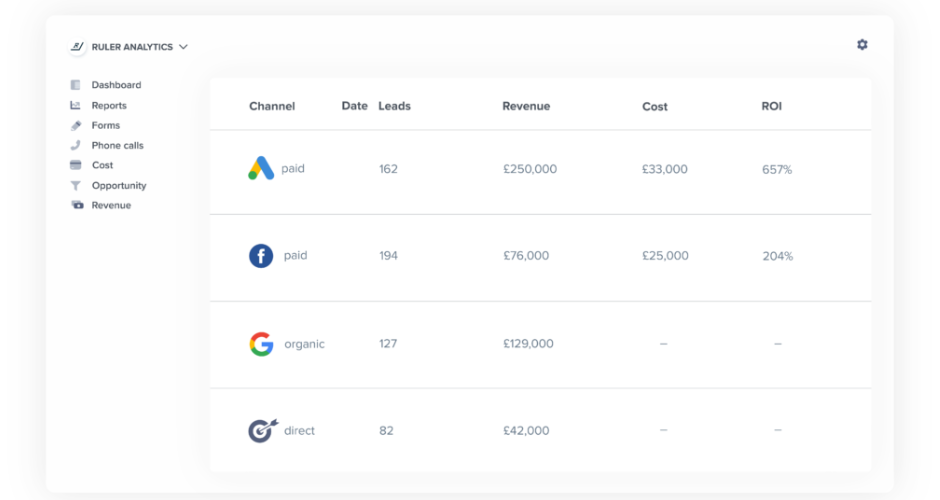
Ruler then matches the customer with their unique marketing touchpoints, allowing us to see how much revenue was generated from each marketing source, keyword and campaign.
With Ruler’s attribution data looping our marketing to sales, we can determine which channels convert leads best and confidently track our revenue metrics like ROI and CPA.
Ruler fits seamlessly into your existing tech stack. It integrates with leading marketing and sales software, including Google Analytics, Google Ads and Facebook.
At Ruler, we use ChartMogul to track changes in revenue from our customers and lifetime value.
In Chartmogul, we’ve set up custom attributes to capture Ruler’s marketing attribution data.
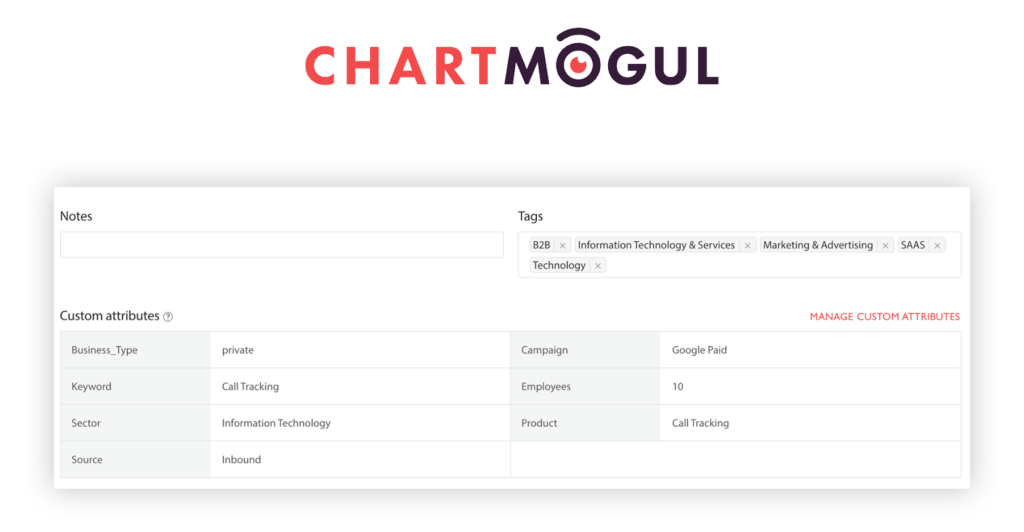
This allows us to create custom reports directly in Chartmogul to show which marketing sources and ad campaigns have the best influence on LTV.
Today’s ever-changing tech landscape depends heavily on data-driven results and forecasts.
Depending on the goals of your business it’s easy to become overwhelmed trying to figure out what data you should (or should not) be analysing for your B2B marketing measurement.
We’ve gone through what other B2B marketers consider as key metrics and we’ve shown you how we measure our B2B marketing here at Ruler.
It just goes to show that with the right tools in place you can easily track exactly which sources are driving higher levels of revenue. Right down to the very keyword that the customer engaged with.
By measuring all of this B2B marketing data you should be in a better position, moving forward, to apply it to future campaigns .You can streamline your B2B marketing efforts with greater certainty thanks to historical data.
Want to learn more about Ruler? See how Ruler can help measure your marketing performance or book a demo and see it in action for yourself.
